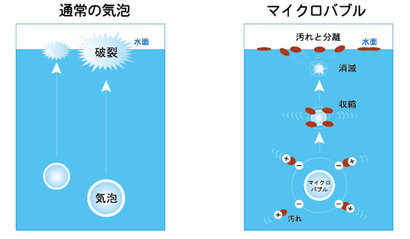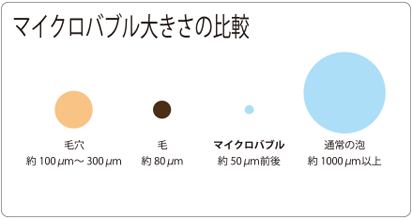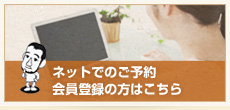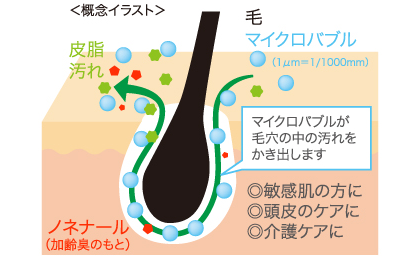「ナノバブルの可能性」 より要約抜粋
産業技術総合研究所 研究主幹 高橋正好
泡は本来水の中を急速に浮上して表面で破裂して消えるものである。
ところがこの泡を目に見えないほど小さくすると通常の泡とは異なった特徴が表れ、驚くべき効果をもたらす。
この水の中で消える(もしくは消えるように見える)小さな気泡をマイクロバブルと呼んでいる。
実は水の中で小さくなって消えるという現象に大変に重要な意味があることが分かってきた。


消える直前には内部の気体はもの凄い高圧力となる。また、気泡自体はイオンの塊となる。
気体の種類を変えるなどの工夫をすると、
有害な化学物質を分解したり、菌やウイルスを不活化させたり、はたまた植物や動物を元気にしたりする効果が現れる。
何とも不思議な世界である。
マイクロバブルにはどの様な特徴があるのであろうか? 重要な特徴は次の二点である。
・気泡の内部の圧力が高い
・気泡の表面は帯電している
水の中に電極を配して、プラスとマイナスを交互に切り替えると、それにつれてマイクロバブルはジグザグ運動をしながら上昇する。これは気泡が帯電しているためである。
また気泡が消えた瞬間にイオン群は開放される。その時のエネルギーの一部が水などの分子を分解してフリーラジカルを生じる。ある環境条件を与えてやると、水酸基ラジカルが発生する。我々はこれを利用して有害な有害化学物質を分解除去したり、半導体などの洗浄に利用したりしている。 また、このマイクロバブルを含む水をシャワー状に散布してやると気中の有機物や臭気を除去できることも明らかになってきた。
また農業への効果もおもしろい。農薬や肥料を使わなくても米が取れる。イチゴの収穫が増える。立派なガーベラの花が咲く。まだメカニズムは分からないが、田圃にはカブトエビが出現して雑草の種を食べてくれる。植物の根が驚くほど張って病気にも強くなる。医療や衛生の分野においては、オゾンという気体をナノバブルにすることで、人や動物は平気なのに、菌やウイルスを除去することが出来る。
ーーーーーーーーーーーーーーーーーーーーーーーーーーーー
この夢のような話は
シャワーヘッドを交換するだけで実現可能です。【Obleu】
半導体を洗う業務用・牡蠣の養殖時に使い育てながら洗浄するといった産業用の物は数十万〜数百万円します。
家庭用でも浴槽内で発生させるものも数十万円します。
シャワーヘッドの交換なら、約2万円で抑える事ができます。
ーーーーーーーーーーーーーーーーーーーーーーーーーーーー
以下はあくまでも、「私の個人的感想」です。
・毛根の血流が良くなったのか抜け毛が格段に減りました。
・常に肌がスベスベです。
・朝起きた時の顔のテカリ感がなくなりました。
・手先/指先の荒れが生じません。(保湿のおかげ?)
・湯冷めしません。(保温のおかげ?)
・寝起きが非常にスッキリです。(マイナスイオンのおかげ?)
・枕カバーが臭くありません。
・脇、背中、骨盤周辺(ソケイ部など)、肘などの痒みが消え、常にサラサラしています。
・浴槽内に入れれば、湯音が下がりにくいですし、前入った人の後でも追い炊きの時間が短くなります。
・足の指の間を常に清潔に保ててます。
・風呂釜でためたお湯を洗濯で使うと汚れ落ちが良いです。
・浴室の排水口に汚れがたまりにくいです。
・浴室内の汚れ、カビがつきにくくなったようです。
ーーーーーーーーーーーーーーーーーーーーーーーーーーーー
繰り返しになりますがとても重要な事なので、、、
ジェットバスなどの通常の泡は発生した後、水面に浮上して水面ではじけるだけですが、
しかし非常に小さくマイナスイオンを帯びたマイクロバブルは
通常の泡と比べて水中での上昇速度が遅く、長い間水中に浮遊して滞在します。
シャワーヘッドを浴槽の中に入れマイクロバブルを高密度で発生させると、マイナスイオンが大量に発生し、
マイクロバブルはマイナスイオンを帯びているので、
水中に漂うプラスイオンを帯びている「微細な異物」「汚れ」「垢」と結びついて、
ゆっくりと浮上しながら水中で消滅し、汚れを水面に浮かび上がらせる性質を持っています。
つまり、優れた洗浄力があるので、
お風呂につかるだけで、こすらずとも表面の汚れが取れてしまうのです。
更に水圧で自己圧壊(水の圧力により消滅する現象)し、衝撃波が発生する事は確認されています。
これが1秒間に連鎖的に数百回発生すると考えられています。この衝撃波が、皮膚に程よい刺激を与えます。
浴槽で使うのが理想ですが、
湯船・浴槽に入れなくても、シャワーを浴びるだけでも十分この洗浄力は体験できます。
試しに、数分間片腕をシャワーにあててみてください。
数分後にはスベスベになった腕を体感できます。
マイクロバブルは、自然界の数十倍ものマイナスイオンを発生しますので、
ご家庭の浴室で森林浴気分をご堪能できます。
マイナスイオンを補充することにより、一般的に下記のような作用があると言われています。
■自律神経の調整
■精神安定
■細胞の活性化
■免疫強化
■血液の浄化
■血圧の正常化
■アレルギーの体質改善
■肺機能強化
■細菌の増殖抑制
■空気の浄化
ーーーーーーーーーーーーーーーーーーーーーーーーーーーー
ペットのいる家庭はペットを洗いすぎずに済みます。 (匂いが和らぎシャンプーの量が減る)
介護・医療の現場の除菌抗菌除臭に役に立ちます。
皮膚炎(アトピー性皮膚炎など)で悩んでいる方にも効果ありと思っています。
アトピー性皮膚炎はスキンケア(清潔に保つ&保湿)が第一ですから、
お役に立てる(=治るというより悪化を防ぐ)と思っています。
乳幼児にも最適です。
石けんの使用量が減るので敏感肌にとても良いです。
全体的に洗剤の量が減るので、地球にもとっても優しいです。
ーーーーーーーーーーーーーーーーーーーーーーーーーーーー
この一石二鳥どころか、一石十鳥にもなる
シャワーヘッド【Obleu】
MTG の正規代理店である当院で扱っています。
料金は
\23800 (税込み)
(通販・ネット販売はしておりません)
それでも高いと思われるでしょうが、
「シャワーヘッドを交換するだけで年間の光熱費を1万5千円節約できた」
家庭もあります。
2年でお釣りがきますよね? 高いですか?
付属のコラーゲンカートリッジが不要の場合、カートリッジの料金 ¥3300 を差し引きます。
¥23800 → ¥20500
高いと思いますか?
このような販売の仕方している店は他にありませんよ。
腰痛と骨盤の非対称性(左右差)と無関係です。
しかし、、、
「腰痛の原因は骨盤が歪んでいるからです」
と説明する治療家がとても多く、あたかも常識のように扱われています。
迷信であるにも関わらず
「骨盤の歪みを整えることが腰痛を治す方法」
だと信じている患者さんが多いのは社会問題であるとも言えます。
「それでも地球は回っている」と言ったガリレオの心境です。
歪みは、静止時の左右の対称性ではなく、どの方向に無理なく動けるかどうかで判断します。動きにくい方向がある時「歪み」として考えます。
(静止した)立位における骨盤の左右差を検査することはあっても、ここで見つかる左右差を痛みの原因に決めつけることはしません。癖と原因は区別しなければいけません。
骨盤の歪みを腰痛の原因とする考え方は、ビジネスのために仕掛けられたものでしかありません。
O脚矯正なるものも同様です。
あれは、テレビなどのメディア受けをねらっただけで、全く根拠はありません。
<論文の要約>
-----------------------------------------
腰痛患者144名と健常者138名を対象に骨盤の歪みを厳密に測定して腰痛との関連を調べた結果、どのような臨床的意義においても骨盤の非対称性と腰痛は関連していないことが判明。
骨盤の歪みが腰痛の原因というのは迷信に過ぎない。
-----------------------------------------
The association between static pelvic asymmetry and low back pain.
Authors
Levangie PK.
Journal
Spine (Phila Pa 1976). 1999 Jun 15;24(12):1234-42.
Affiliation
Sacred Heart University, Fairfield, Connecticut, USA.
Comment in
Spine (Phila Pa 1976). 2000 Oct 1;25(19):2551-2.
Spine (Phila Pa 1976). 2000 Nov 1;25(21):2845-6.
Abstract
STUDY DESIGN: A cross-sectional case-control approach was used to estimate the association between low back pain of less than 12 months' duration and pelvic asymmetry among 21-50-year-old patients seeking physical therapy services.
OBJECTIVE: To evaluate the premise that asymmetrical positioning of the innominates of the pelvis is a source of low back pain.
SUMMARY OF BACKGROUND DATA: No published studies have been conducted to evaluate systematically the association between low back pain and pelvic asymmetry in a clinic-based sample.
METHODS: Pelvic landmark data were obtained in 144 cases and 138 control subjects. The associations of low back pain with levels of pelvic asymmetry were estimated by use of odds ratios and 95% confidence intervals. Effect modification and confounding of the low back pain-pelvic asymmetry association by several factors was assessed and alternative asymmetry measures considered.
RESULTS: Pelvic asymmetry was not positively associated with low back pain in any way that seemed clinically meaningful. Asymmetry of posterior superior iliac spine landmarks showed some evidence of a weak positive association with low back pain.
CONCLUSIONS: In the absence of meaningful positive association between pelvic asymmetry and low back pain, evaluation and treatment strategies based on this premise should be questioned.
http://t.co/iEvQzim(米国国立医学図書館 国立衛生研究所)
~~~~~~~~~~~~~~~~~~~~~~~~~~~~~~~~~~~
松江はりきゅう治療院
新宿区上落合3-8-25-313
落合駅改札口よりすぐ。
2番出口隣
出口を出たら左に向かって20歩
西武新宿線の中井駅からも徒歩5分。
(症状が辛く歩けない場合は、高田馬場駅で乗換、落合駅までいらしてください。)
新宿駅や中野駅から10分以内で来られます。
大久保/高円寺/阿佐ヶ谷/荻窪/吉祥寺など JR 中央線沿線をご利用の方でもお気軽にどうぞ。
落合駅は高田馬場駅の隣駅です。
東西線や西武新宿線沿線ををご利用の方もお気軽にどうぞ。
新宿駅より10分 東西線落合駅の真上
肩こり/腰痛/スポーツ障害で鍼灸治療をお探しの方は 松江はりきゅう治療院へ
Grow Up Strengthより、体幹部の安定についての文献をまとめたブログ記事をご紹介します。
体幹部の機能解剖、ドローイン・ブレーシング2つの技術とそれらの使い分けについてまとめられています。
さらに記事の最後でHemsworth氏は、専門家同士の批判合戦について言及しています。
”自分のやり方が1番で他はダメ”という考えではなく、様々なメソッドについてメリット・デメリットを理解しクライアントに一番あったやり方をご紹介する、”コンシェルジュ的トレーナー”が今後は求められると考えています。
-----
Analyzing Core Stabilization Technique - Bridging the Gap
”体幹部の安定”というトピックはよく聞くであろう。最近のフィットネス業界で乱用されているキーワードであるが、”果たして本当に正しい情報がクライアントに伝わっているか?”
体幹部の安定とは何なのか?
これは100人のスポーツ科学者に聞けば100通りの答えが出てくるくらい難しい問題です。
体幹部の安定とは、”スタティックまたはダイナミックな動作中にいかなる運動エネルギーのロスも無いように、脊柱とその周囲を安定させる能力”のことである。
一流アスリートが力強く無駄のない動きが可能な理由を知れば、脊柱への負担を最小限に減らつつ最も効率的な動作ができる理由もわかるであろう。
体幹部の機能解剖学
内・外腹斜筋:
腹直筋と共に脊柱の屈曲に大きな役割を果たし、腰椎の側屈・回旋と安定性への関与も深い。さらに息を吐き出す際にも活性化する。
腹横筋:
胸部の回旋、胸腔・腹腔の内圧向上に関与し、排便時にも重要。
腹直筋:
体幹部の主な屈曲筋で、腹斜筋群と共に脊柱の”囲い”を形成し相互に運動エネルギーの伝達を行う。
回旋筋:
筋紡錘が多く分布するため脊柱のポジションを安定させる上では、他の脊柱回旋筋より重要な役割を果たす。
回旋筋は腹斜筋群と広背筋が生み出す、”脊柱を回旋させる力”に対して拮抗する力を発揮するときに最も活性化される。
脊柱起立筋群・最長筋&腸肋筋:
胸部と腰部にまたがり、脊柱を伸展させる主動筋である。
多裂筋:
脊柱の伸展にも関与するが、脊柱が外部ストレスに耐えられるように各椎骨のポジションを調整する役割が大きい。
腰方形筋:
腰椎を両側から支える柱・壁の役割を果たす。
大腰筋:
股関節屈曲主動筋で起始がT12~L5であるため、脊柱の安定に関与すると考えられる。
体幹部安定のメカニズム:
ドローイン(Abdominal Hollowing) vs ブレーシング(Abdominal Bracing)
腰部を負傷した後、腹横筋と多裂筋は正常に機能せず、身体全体の筋活性にも影響を及ぼすとされている。
ドローインでは腹横筋のみを分離して働かせ、腹直筋と腹斜筋群はリラックスさせている状態のことである。
ブレーシングは、脊柱を取り囲む腹直筋、腹斜筋群、腹横筋、多裂筋、広背筋、腰方形筋と脊柱伸展筋群を共同で活性化させ、安定させることを目的としている。
ブレーシング中はお腹を凹ませたり膨らませたりせずに、腹腔を内側から押し上げて広げるようにする。
もし誰かがあなたの腹を殴ろうとするときに、あなたはきっとお腹周りを固くして、パンチの衝撃に耐えながら脊柱の安定を図ることでしょう。
ドローインとブレーシングをどう使い分けるか?
体幹部安定と脊柱周囲筋の活性化を目的としたテクニックには違いがある。
クライアントが急性・慢性障害のリハビリテーションを目的にしてあなたを訪ねて来た場合、その一環で筋バランスや活性パターンの適正化を図るのは当然である。
負傷前には無意識でできたドローインを再教育する。
また、無く何らかの目的で強くなりたいと望むクライアントであれば、より強度の高い運動を行わなければならないため、ブレーシングを身につけさせなければいけない。
リハビリでもストレングスが目的であっても、両方のテクニックに筋活性パターンの再教育、筋の分離と共同性の確立といった利点があるので、手法はあくまでクライアントの状況に合わせて選択すべきである。
http://www.gustrength.com/training:core-stabilization-bridging-the-gap/comments/show
Analyzing Core Stabilization Techniques - Bridging the Gap
» Ground Up Strength Categories » Training » Core Strength And Stability » Analyzing Core Stabilization Techniques - Bridging the Gap
As most of you know, the world of core stabilization has yielded as much attention as Paris Hilton buying a new Chihuahua. The difference: core stabilization warrants most of the attention it gets. I say "most" because as with many catchy terms in the fitness industry, it can be abused with the content that goes into defining these terms. However, for the sake of this article I am going to review what I feel to be the more logical techniques that are involved in stabilizing that snake-like structure we call the spine.
What is Core Stabilization?
That's the million dollar question isn't it? If you asked 100 different sport scientists that question, you would get 100 different answers. To me, core stabilization is the ability to create uncompromising stiffness around the spine as to not allow any "energy leaks" during various static or dynamic tasks. You may agree or disagree with me on that definition, but the bottom line is this: Whether you are an elite athlete, construction worker, or receptionist, chances are you will probably go through some sort of back pain in your life. So throw the 6-pack talk out the window for now and start thinking about the spine. If we can ensure the athlete is a column of strength with no loose kinks in the chain, then we can ensure optimal power with minimal force loads on the spine.
Stability Ball Exercise Progressions for Building Muscle and Core Strength
Dead Bug Track (Using Posterior Pelvic Tilt)
First, let's look at the anatomy.
Internal & External Obliques (IO & EO): Involved in flexion, as their forces are redirected to the rectus abominis (RA) to enhance the flexor potential. They are involved in lateral bending, twisting, and stabilization of the lumbar spine (McGill, 1991a, 1991b, 1992; Juker, McGill, and Kropf, 1998). Lastly, they are involved in active expiration (Henke et al., 1988).
Transverse Abdominis: Rotates thorax from side to side, increases interthoracic pressure, and is involved in defecation, urination, childbirth. The TA is also an anticipatory muscle.
Rectus Abdominis (RA): The major flexor of the trunk. It forms a continuous hoop around the spine by transferring the forces from the obliques. The upper and lower RA are activated together and at similar rates during flexion (Lehman & McGill, 2001): So throw your "upper and lower abdominal exercises" out the window.
Rotatores: Have a high number of muscle spindles and thus serve more as a spinal positioner than a rotator of the spine (Nitz & Peck, 1986). They are most active when trying to resist the rotation of the spine that the obliques and latissimus are likely causing.
Extensors
Longissimus & Iliocostalis: Have thoracic and lumbar components. These are the major back extensors.
Multifidus: Extension of the spine but only through the correcting of spinal joints that are enduring stress. Line of action actually contributes to shearing forces of superior vertebrae.
Quadratus Lumborum (QL): Bilateral support wall or stabilizer for the lumbar spine. The QL is active during flexion, extension, and lateral bending of the spine and maybe one of the few muscles that doesn't turn off during the flexion/relaxation phenomenon.
Psoas: Major hip flexor. May assist in some stabilization due to its orientation (Origin is T12-L5).
Core Stabilization Mechanisms
Abdominal Hollowing vs. Abdominal Bracing.
The abdominal hollowing technique was essentially developed from a group of Australian sport scientists (Richardson et al. 1999). This "Queensland group" determined that the transverse abdiminis (TA) and multifidus (MT) muscles in particular, were very important muscles for motor patterning. They found that following injury to the back, the TA and MT underwent motor disturbances that had profound effects on the motor patterning of the body. Because further injury would just add to these effects leading to a chronic state of poor patterning and pain, the Queensland group argued that only specific abdominal activation techniques could break this poor programming. Thus was born the abdominal hollowing technique: This technique involves the drawing in of the abdomen in an attempt to isolate the TA, while relaxing the surrounding musculature (RA, IO, EO).
The abdominal bracing technique was primarily developed - or more appropriately, coined - by Canadian biomechanist Stuart McGill. This technique involves the co-activation of all the muscles surrounding the spine (RA, IO, EO, TA, MT, Latissimus, QL, and the extensors) in an attempt to create 360 degrees of stability. While bracing, the individual doesn't draw in or push out, but rather "braces" or widens the trunk. If you think about what you would do if someone was to punch you in the stomach: You would set or brace for the punch and effectively create stability all the way around the spine. (For more on abdominal bracing, see Ultimate Back Fitness & Performance by Stuart McGill).
To Brace or Hollow: That is the question.
Much of the data that came out of the Queensland research was misinterpreted. Because they were working with injured individuals with malfunctioning motor patterns, the techniques they came up with were an attempt to disrupt the faulty patterns and educate the patients on abdominal control. Moreover, the TA anticipates trunk, upper and lower limb movement as well as protects the spine (Hodges, 1999). This anticipatory and protective function can be lost with acute or chronic low back pain. However, many clinicians took this information and regarded the techniques as a way of creating optimal core stability during various tasks. Thus, abdominal hollowing seems to be the preferred choice of many physiotherapists, strength coaches, chiropractors and kinesiologists for core stabilization.
Enter Stuart McGill! Not dismissing the importance of these muscles in their role as intra-abdominal pressure creators and stabilizers, McGill and others have since argued that this is simply not enough to endure tasks of even moderate intensity. Furthermore, during athletic events, unpredictable forces from all directions occur in almost any sport. Specifically, if a posterior perturbation - or unsuspected push from behind - occurs on the spine (lets say a defensive stiff-arm as you lean into a defender in basketball), abdominal hollowing produces the same resistance to the force that no activation does and results in an increase in spinal flexion (vs. 43% reduction of spinal flexion when bracing is used) (Vera-Garcia et al. 2007). As kettlebell lifter and educator Brett Jones says, if you took a cardboard box on its side and loaded it from the top, the box would crumble. Just ask Human Motion's Cliff Harvey what would have happened if he drew his stomach in while attempting world record lifts in weightlifting: He too would have crumbled. Furthermore, it is almost certain that if you try to contract only the TA, you will have activity in the IO and EO as well.
When the muscles surrounding the spine co-contract, they create a stiffness that is greater than the sum of the individual muscle stiffness (McGill, 2006). Thus, during the hollowing procedure, you are actually inhibiting the potential for optimal stiffness, ultimately limiting performance. You would think that in order to brace properly and ensure "superstiffness" that you would need to have an all out contraction during most activities. However, this doesn't seem to be the case as the first 25% of a maximal abdominal contraction creates sufficient stiffness for most activities (Brown & McGill, 2005). During 1RM lifts such as Cliff's world record attempts however, a maximum voluntary contraction (MVC) of all the surrounding musculature is necessary to withstand the massive force.
Let's hug it out: We are dealing with apples and oranges
There seems to be a lack of understanding as to the different techniques used between physios and strength coaches for core stabilization and activation. When a patient is seeing a physio, they are exactly that - a patient. Most of the time they are coming from an injury and have consequently obtained faulty patterns within their muscle sequencing. On the other hand, they could have had years of overuse injuries or poor gait biomechanics that has led to muscular imbalances. Thus, abdominal hollowing seems to be the technique of choice to help create that control that probably was never there even before the "injury" brought them to rehab. THIS IS PERFECTLY FINE. This is our group of apples. Our group of oranges are either these same patients coming from physio or our uninjured group of individuals who need to get stronger. Once these individuals are able to withstand heavier forces and are loaded up with weights, abdominal hollowing is no longer sufficient to lift this kind of weight, while sparing the spine. Thus, the abdominal brace must be taught. Herein lies the problem. We are constantly nagging each other (various health care practitioners) about the different techniques used. We need to remember that it is the needs of the client/patient that is our primary concern. WE NEED TO EDUCATE AND PREPARE THEM FOR THE NEXT STEP. Physios: Inform the patient that if they are an athlete or they are going to be lifting weights in the future, they will have to learn both techniques. Strength coaches: Actually integrate both techniques into your training. Isolate then integrate. It is a great way to allow the client to achieve initial success (abdominal hollowing) and then allow them to see the big picture of lifting heavier loads (abdominal bracing).
An integrated team approach can produce great success for the athlete, however, all members need to be on the same page even if their philosophies differ. Work with each other to produce the best results for the client/patient. Your athlete will ultimately be stronger, safer, and less confused in the process!
References
Brown, & McGill . (2005). Muscle force-stiffness characteristics influence joint stability: A spine example. Clinical Biomechanics, 20(9), 917.
Henke, Sharratt, Pegelow, & Dempsey, (1988). Regulation of end-expiratory lung volume during exercise. Journal of Applied Physiology, 64(1), 135.
Hodges (1999). Is there a role for transversus abdominis in lumbo-pelvic stability? Manual Therapy, 4(2), 74.
Juker, Mcgill, & Kropf, (1998). Quantitative intramuscular myoelectric activity of lumbar portions of psoas and the abdominal wall during a wide variety of tasks. Medicine and Science in Sports and Exercise, 30(2), 301.
Lehman & McGill, (2001). Quantification of the differences in electromyographic activity magnitude between the upper and lower portions of the rectus abdominis muscle during selected trunk exercises. Physical Therapy, 81(5), 1096.
McGill, (1991a). Electromyographic activity of the abdominal and low back musculature during the generation of isometric and dynamic axial trunk torque: Implications for lumbar mechanics. Journal of Orthopaedic Research, 9(1), 91.
McGill, (1991b). Kinetic potential of the lumbar trunk musculature about three orthogonal orthopaedic axes in extreme postures. Spine, 16(7), 809.
McGill, (1992). A myoelectrically based dynamic 3-D model to predict loads on lumbar spine tissues during lateral bending. Journal of Biomechanics, 25(4): 395.
McGill, (2006). Ultimate back fitness and performance. Waterloo, ON: Backfitpro Inc.
Nitz & Peck, (1986). Comparison of muscle spindle concentrations in large and small human epaxial muscles acting in parallel combinations. The American Surgeon, 52(5), 273.
Richardson, Jull, Hodges, & Hides, (1999). Therapeutic exercise for spinal segmental stabilization in low back pain. Edinburgh, Scotland: Chruchill Livingstone.
Vera-Garcia, Elvira, Brown, & McGill (2007). Effects of abdominal stabilization maneuvers on the control of spine motion and stability against sudden trunk perturbations. Journal of Electromyography and Kinesiology, 17(5), 556.






















































